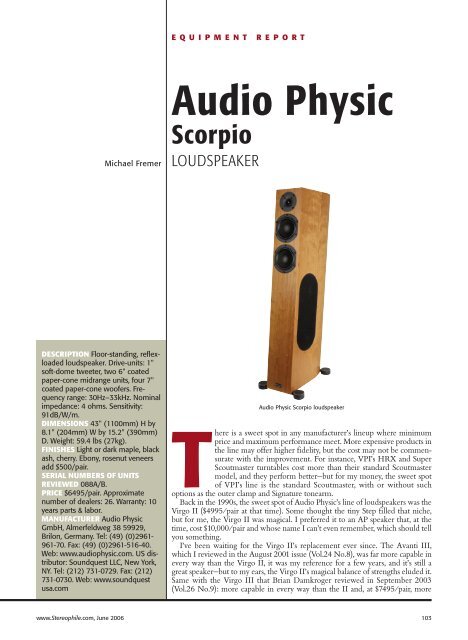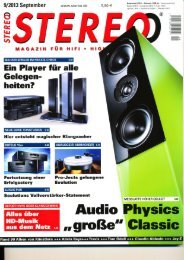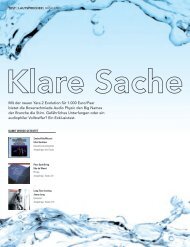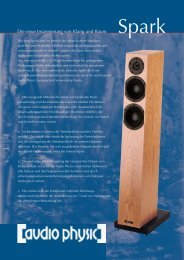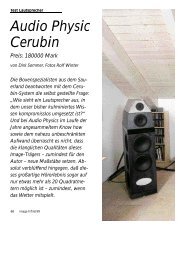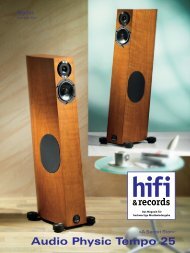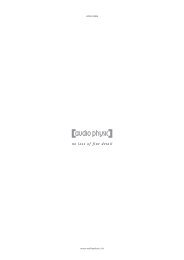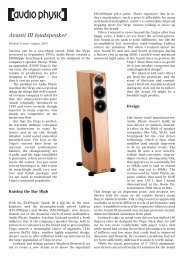Audio Physic Scorpio
Audio Physic Scorpio
Audio Physic Scorpio
- TAGS
- audio
- physic
- scorpio
- audiophysic.de
You also want an ePaper? Increase the reach of your titles
YUMPU automatically turns print PDFs into web optimized ePapers that Google loves.
Michael Fremer<br />
DESCRIPTION Floor-standing, reflexloaded<br />
loudspeaker. Drive-units: 1"<br />
soft-dome tweeter, two 6" coated<br />
paper-cone midrange units, four 7"<br />
coated paper-cone woofers. Frequency<br />
range: 30Hz–33kHz. Nominal<br />
impedance: 4 ohms. Sensitivity:<br />
91dB/W/m.<br />
DIMENSIONS 43" (1100mm) H by<br />
8.1" (204mm) W by 15.2" (390mm)<br />
D. Weight: 59.4 lbs (27kg).<br />
FINISHES Light or dark maple, black<br />
ash, cherry. Ebony, rosenut veneers<br />
add $500/pair.<br />
SERIAL NUMBERS OF UNITS<br />
REVIEWED 088A/B.<br />
PRICE $6495/pair. Approximate<br />
number of dealers: 26. Warranty: 10<br />
years parts & labor.<br />
MANUFACTURER <strong>Audio</strong> <strong>Physic</strong><br />
GmbH, Almerfeldweg 38 59929,<br />
Brilon, Germany. Tel: (49) (0)2961-<br />
961-70. Fax: (49) (0)2961-516-40.<br />
Web: www.audiophysic.com. US distributor:<br />
Soundquest LLC, New York,<br />
NY. Tel: (212) 731-0729. Fax: (212)<br />
731-0730. Web: www.soundquest<br />
usa.com<br />
EQUIPMENT REPORT<br />
<strong>Audio</strong> <strong>Physic</strong><br />
<strong>Scorpio</strong><br />
LOUDSPEAKER<br />
<strong>Audio</strong> <strong>Physic</strong> <strong>Scorpio</strong> loudspeaker<br />
There is a sweet spot in any manufacturer’s lineup where minimum<br />
price and maximum performance meet. More expensive products in<br />
the line may offer higher fidelity, but the cost may not be commensurate<br />
with the improvement. For instance, VPI’s HRX and Super<br />
Scoutmaster turntables cost more than their standard Scoutmaster<br />
model, and they perform better—but for my money, the sweet spot<br />
of VPI’s line is the standard Scoutmaster, with or without such<br />
options as the outer clamp and Signature tonearm.<br />
Back in the 1990s, the sweet spot of <strong>Audio</strong> <strong>Physic</strong>’s line of loudspeakers was the<br />
Virgo II ($4995/pair at that time). Some thought the tiny Step filled that niche,<br />
but for me, the Virgo II was magical. I preferred it to an AP speaker that, at the<br />
time, cost $10,000/pair and whose name I can’t even remember, which should tell<br />
you something.<br />
I’ve been waiting for the Virgo II’s replacement ever since. The Avanti III,<br />
which I reviewed in the August 2001 issue (Vol.24 No.8), was far more capable in<br />
every way than the Virgo II, it was my reference for a few years, and it’s still a<br />
great speaker—but to my ears, the Virgo II’s magical balance of strengths eluded it.<br />
Same with the Virgo III that Brian Damkroger reviewed in September 2003<br />
(Vol.26 No.9): more capable in every way than the II and, at $7495/pair, more<br />
www.Stereophile.com, June 2006 103
expensive than the <strong>Scorpio</strong>, but lacking<br />
the II’s mojo.<br />
After my less-than-enthusiastic<br />
review of <strong>Audio</strong> <strong>Physic</strong>’s Caldera<br />
($30,000/pair) in November 2005,<br />
credit AP and their importer, Gabby<br />
Amram of Soundquest LLC, for giving<br />
me the opportunity to review the <strong>Scorpio</strong>,<br />
which I requested after hearing a<br />
short demonstration at the Consumer<br />
Electronics Show in January. In fact,<br />
walking into AP’s room at CES 2006<br />
not long after that Caldera review had<br />
been published was, um, interesting.<br />
When I encountered <strong>Audio</strong> <strong>Physic</strong>’s<br />
MEASUREMENTS<br />
AUDIO PHYSIC SCORPIO<br />
The <strong>Audio</strong> <strong>Physic</strong> <strong>Scorpio</strong> has a high specified sensitivity<br />
of 91dB/W/m. However, measured on its<br />
tweeter axis without the grille, the speaker<br />
appeared to have just above average voltage sensitivity,<br />
at an estimated 88.5dB(B)/2.83V/m. Its impedance<br />
(fig.1) stays between 4 and 6 ohms over most of<br />
the audioband, with a minimum value of 3.6 ohms at<br />
93.5Hz. There is also a combination of 5.2 ohms and a<br />
–41° electrical phase angle at 78Hz, which might be taxing<br />
for optimistically specified power amplifiers, given<br />
that many kinds of music tend to have a lot of energy at<br />
this frequency.<br />
A discontinuity is visible in the impedance traces at<br />
125Hz, suggesting some kind of resonance. However,<br />
while a cumulative spectral-decay plot (calculated from<br />
the output of an accelerometer fastened to the front baffle<br />
and level with the center of the side-mounted woofers)<br />
revealed a major vibrational mode at 266Hz (fig.2), the<br />
other panels were relatively well-behaved and nothing<br />
was evident at 125Hz.<br />
The saddle centered between 30Hz and 40Hz in the<br />
impedance-magnitude trace suggests that the rear- and<br />
bottom-facing ports are tuned to a low frequency. The<br />
green trace in fig.3 shows the summed acoustic output of<br />
the ports, measured in the nearfield and scaled in the proportion<br />
of the square root of the total radiating area com-<br />
Fig.1 <strong>Audio</strong> <strong>Physic</strong> <strong>Scorpio</strong>, electrical impedance (solid) and phase<br />
(dashed). (2 ohms/vertical div.)<br />
business manager, Dieter Kratochwil,<br />
and asked him how the show was<br />
going, he looked me straight in the eye<br />
and said, “Until just now? Fine!” I<br />
loved his honesty and had a good laugh<br />
(to myself). Had our roles been<br />
reversed, I’m sure I wouldn’t have been<br />
thrilled to see him, either.<br />
<strong>Scorpio</strong><br />
<strong>Audio</strong> <strong>Physic</strong>’s <strong>Scorpio</strong> is a rear- and<br />
bottom-ported design that could be<br />
considered a smaller version of designer<br />
Manfred Diestertich’s bottom-ported<br />
Avanti III ($12,495/pair) or a larger ver-<br />
sion of AP’s Tempo ($3995/pair). Either<br />
view would probably suit <strong>Audio</strong> <strong>Physic</strong>,<br />
who intend the <strong>Scorpio</strong> to bridge the<br />
gap between those two models. The<br />
<strong>Scorpio</strong> costs $6495/pair–$6995/pair,<br />
depending on finish.<br />
It’s also handsome. The complex,<br />
well-braced cabinet, manufactured by<br />
Hornslet in Denmark using that company’s<br />
patented Hornflex technology,<br />
features a narrow front baffle tilted<br />
back 7°, and nonparallel side panels<br />
that curve toward the rear. Unlike the<br />
curvaceous Avanti III, though, the<br />
<strong>Scorpio</strong>’s rear surface is flat. The<br />
pared with those of the woofers and the midrange units. A<br />
little down in level, it doesn’t fully extend the <strong>Scorpio</strong>’s<br />
low-frequency response, though this graph does not take<br />
into account the fact that the bottom port’s output will be<br />
reinforced by the floor. The ports will also relieve the<br />
woofers of high midbass excursions. The trace also has<br />
some resonant peaks evident in the midrange, though<br />
these are well down in level, and there is a small peak present<br />
at 125Hz.<br />
Fig.2 <strong>Audio</strong> <strong>Physic</strong> <strong>Scorpio</strong>, cumulative spectral-decay plot calculated from<br />
the output of an accelerometer fastened to the cabinet’s front baffle<br />
level with the woofers (MLS driving voltage to speaker, 7.55V;<br />
measurement bandwidth, 2kHz).<br />
Fig.3 <strong>Audio</strong> <strong>Physic</strong> <strong>Scorpio</strong>, anechoic response on tweeter axis at 50",<br />
averaged across 30° horizontal window and corrected for<br />
microphone response, with the nearfield responses of the midrange<br />
units (blue), woofers (red), ports (green), and their complex sum<br />
(black).<br />
104 www.Stereophile.com, June 2006
veneer and overall fit’n’finish are<br />
exceptional. This graceful-looking,<br />
ideally proportioned speaker would<br />
be at home in the swankest living<br />
room—especially in the review pair’s<br />
ebony finish.<br />
The foundation of the <strong>Scorpio</strong>’s<br />
sound is provided by four 7" papercone<br />
woofers: two on each side operating<br />
in push-push configuration, which<br />
is said to cancel cabinet resonances. The<br />
lower of the two front-mounted 6"<br />
coated-paper-cone drivers operates as a<br />
midbass/lower-midrange driver from<br />
150 to 500Hz, while the upper one<br />
operates between 150Hz and 2.8kHz,<br />
and hands the signal off to a 1" modified<br />
soft-dome tweeter.<br />
measurements, continued<br />
The minimum-motion point of the woofers’ summed<br />
outputs (fig.3, red trace) occurs at a fairly low 38Hz, with a<br />
response rise above that frequency peaking between 80Hz<br />
and 100Hz. Most of this peak will be due to the exaggerating<br />
effect of the nearfield measurement, which assumes a<br />
2pi (half-space) acoustic environment. Even so, the <strong>Scorpio</strong>’s<br />
upper bass is a little rich in absolute terms, its midbass<br />
shelved-down. A suckout is evident at 300Hz in the<br />
woofers’ response, with only a gentle rollout evident above<br />
that frequency.<br />
The midrange units differ a little, in that the lower driver<br />
gently rolls off above 450Hz while the upper driver continues<br />
upward in frequency to cross over to the tweeter at a<br />
measured 2.4kHz. The sum of the nearfield midrange<br />
responses (fig.3, blue trace) crosses over to the woofers at<br />
150Hz, with an approximate second-order rollout broken<br />
by a notch at 93Hz. Higher in frequency, the upper<br />
midrange is impressively flat on the tweeter axis, but with<br />
an alarming suckout in the presence region. This lack of<br />
energy—presumably due to destructive interference<br />
between the tweeter and midrange-unit outputs on this<br />
axis, which is 41" from the floor—would help explain why<br />
the <strong>Scorpio</strong>’s measured sensitivity was lower than the<br />
specified figure.<br />
Fig.4 <strong>Audio</strong> <strong>Physic</strong> <strong>Scorpio</strong>, vertical response family at 50", normalized to<br />
response on tweeter axis, from back to front: differences in response<br />
15–5° above axis, reference response, differences in response 5–15°<br />
below axis.<br />
COLD OUT OF THE BOX,<br />
THE SCORPIOS<br />
PRODUCED AN<br />
UNMISTAKABLY<br />
COHERENT PICTURE.<br />
Like the Caldera and other recent<br />
AP speakers, the <strong>Scorpio</strong> has, on its<br />
rear panel, a massive, elastomer-suspended<br />
vibration-control plate of<br />
solid aluminum that contains the<br />
speaker terminals. Spiked metal crossbraces<br />
attached to its base support the<br />
cabinet.<br />
No loss of fine detail?<br />
The <strong>Scorpio</strong>s offered the best tonal<br />
balance and spatial presentation when<br />
placed in the same positions other<br />
<strong>Audio</strong> <strong>Physic</strong> speakers have occupied<br />
in my room, give or take a few critical<br />
inches one way or another. This was<br />
no surprise—room dimensions play a<br />
major role in speaker and listening-seat<br />
positions, and the <strong>Scorpio</strong>s ended up<br />
where most speakers, regardless of<br />
brand, end up in my room. <strong>Audio</strong><br />
<strong>Physic</strong> supplies one of the most informative<br />
set of speaker-setup instructions<br />
I’ve seen, though the English<br />
translation could be reworked to provide<br />
greater clarity.<br />
Cold out of the box, the <strong>Scorpio</strong>s<br />
The depth of this suckout was very critical regarding the<br />
measurement axis. Moving the microphone 1" higher<br />
reduced its depth. How the <strong>Scorpio</strong>’s anechoic response<br />
changes in the vertical plane is shown in fig.4, with the<br />
Fig.5 <strong>Audio</strong> <strong>Physic</strong> <strong>Scorpio</strong>, anechoic response on axis 43" from the floor at<br />
50", averaged across 30° horizontal window and corrected for<br />
microphone response, with the complex sum of the nearfield driveunit<br />
responses.<br />
Fig.6 <strong>Audio</strong> <strong>Physic</strong> <strong>Scorpio</strong>, spatially averaged, 1 ⁄3-octave response in MF’s<br />
listening room.<br />
106 www.Stereophile.com, June 2006
produced an unmistakably coherent<br />
picture. The musical message solidified,<br />
leaving only faint traces of<br />
mechanical artifacts that might have<br />
been described as bass or treble. Like<br />
any other speaker, of course, the <strong>Scorpio</strong><br />
had a sonic signature. What’s critical<br />
to a speaker’s success is making<br />
sure that signature cuts across all<br />
design parameters. For example, if<br />
you’re going to have soft and supple<br />
bass, you don’t want to couple that<br />
with aggressively fast transients and<br />
spotlit high frequencies.<br />
One reason the Vienna Acoustics<br />
Beethoven Concert Grand struck me<br />
as a success (see my review in the May<br />
2006 issue) was its consistency: deli-<br />
AUDIO PHYSIC SCORPIO<br />
tweeter-axis response subtracted from each trace so that<br />
just the changes in response are plotted. The crossoverregion<br />
suckout starts to fill in as you move your ears above<br />
the tweeter axis, but deepens below that axis—which is<br />
perverse, considering that the average seated person’s ear<br />
height is 36". But the treble response isn’t very flat even<br />
above the tweeter axis, as can be seen in the response<br />
averaged across a 30° horizontal window 45" from the<br />
floor (fig.5). While the suckout is less severe, the top two<br />
octaves are elevated on this axis, which is why Mikey<br />
found the speaker to sound bright when he stood up.<br />
What matters to the listener, of course, is the sound in<br />
the room. Fig.6 shows the spatially averaged response produced<br />
by the pair of <strong>Scorpio</strong>s, measured at the ear position<br />
in Michael Fremer’s listening room. Only a mere trace<br />
of the presence-region suckout can be seen, and other<br />
than a small peak in the region where the woofers had<br />
their nearfield peak and a slight lack of energy in the<br />
125Hz band, the <strong>Audio</strong> <strong>Physic</strong>s’ room response is superbly<br />
flat from 100Hz to 10kHz. Above that frequency, the inroom<br />
energy drops due to the tweeter’s limited dispersion.<br />
The plots of the <strong>Scorpio</strong>’s dispersion in the lateral plane—<br />
fig.7 shows the actual responses plotted from 90° on one<br />
side of the tweeter axis to 90° on the other, while fig.8<br />
shows just the differences—reveal that the suckout in the<br />
Fig.7 <strong>Audio</strong> <strong>Physic</strong> <strong>Scorpio</strong>, lateral response family at 50", from back to<br />
front: responses 90–5° off axis, tweeter-axis response, responses<br />
5–90° off axis.<br />
AFTER A WEEK OF<br />
HEAVY POUNDING,<br />
THE [SCORPIO] SEEMED<br />
TO LET GO OF ITS<br />
DEFENSIVE POSTURE…<br />
cate, smooth, silky trebles; warmish<br />
mids; and supple, textured bass. From<br />
top to bottom, the Beethoven was less<br />
about attacks and more about textures<br />
and harmonics, though it provided sufficient<br />
balance in every parameter. Out<br />
of the box, the <strong>Scorpio</strong>s were more<br />
about air, attack, transient detail, and<br />
spatiality, but didn’t fail to provide the<br />
harmonic underpinnings, the supple<br />
textures, the required delicacy to<br />
sound both exciting and inviting.<br />
Before break-in—or after I’d gotten<br />
used to its sound, which is how those<br />
who don’t believe in speaker break-in<br />
would characterize it—the <strong>Scorpio</strong><br />
sounded somewhat tight on top and a<br />
bit brittle, mechanical, and stiff in the<br />
upper bass and lower mids. But after a<br />
week of heavy pounding, the speaker<br />
seemed to let go of its defensive posture<br />
and began delivering a purely<br />
musical picture.<br />
But even in those first few encounters,<br />
the <strong>Scorpio</strong> did a very Virgo<br />
II–like thing: I’d be sitting in my listen-<br />
presence region is confined to a region 15° either side of the<br />
primary axis. At more extreme angles the speaker’s output<br />
becomes quite flat, other than the usual rolloff in the top<br />
octave due to the dome tweeter’s increasing directivity in<br />
this region. So while the direct sound of the <strong>Scorpio</strong> experienced<br />
by a listener sitting with his ears on or just below the<br />
tweeter axis will lack presence, the room’s reverberant field<br />
Fig.8 <strong>Audio</strong> <strong>Physic</strong> <strong>Scorpio</strong>, lateral response family at 50", normalized to<br />
response on tweeter axis, from back to front: differences in response<br />
90–5° off axis, reference response, differences in response 5–90° off<br />
axis.<br />
Fig.9 <strong>Audio</strong> <strong>Physic</strong> <strong>Scorpio</strong>, step response on tweeter axis at 50" (5ms time<br />
window, 30kHz bandwidth).<br />
www.Stereophile.com, June 2006 107
ing chair working on my laptop while<br />
casually listening, and suddenly something<br />
in the recording—often, a voice in<br />
a chorus—would sound so real, as if it<br />
were here in the room, that it would<br />
startle me, setting off a stand-and-fight<br />
rush of adrenaline.<br />
Snap your fingers in front of your<br />
face while moving your hand from side<br />
to side and you have the <strong>Scorpio</strong>’s message.<br />
It lays out the picture in authoritatively<br />
three-dimensional space on a<br />
wide, deep stage of surprising height<br />
for a speaker only 3.6' tall, providing<br />
the “Where’d the speakers go?” transparency<br />
I remember from my first<br />
encounter with the Virgo II.<br />
I was moved early on to pull wellrecorded<br />
live albums from the shelves.<br />
I was never disappointed by the <strong>Scorpio</strong>s’<br />
ability to transform my listening<br />
space into the Village Vanguard, the<br />
Village Gate, Carnegie Hall, Town<br />
Hall, or any of the other New York<br />
City spaces in which those records<br />
were recorded, and in which I’ve often<br />
heard music live. The Vanguard is a<br />
cramped basement with a low ceiling<br />
and a triangular stage wedged into one<br />
corner. When you listen to Bill Evans’<br />
Waltz for Debby (45rpm LPs, Riverside/Analogue<br />
Productions), for<br />
instance, though it’s closely miked,<br />
you can almost feel the walls closing in<br />
on the musicians. But when you do<br />
measurements, continued<br />
AUDIO PHYSIC SCORPIO<br />
will have a full measure of energy in this region. The larger<br />
or more reverberant the room and the farther away the listener<br />
sits, the more the <strong>Scorpio</strong>’s treble will sound neutrally<br />
balanced. Conversely, the smaller and deader the room, the<br />
more the speaker will sound distant, lifeless, and hollow. But<br />
these plots do suggest that <strong>Scorpio</strong> owners experiment with<br />
toe-in to get a satisfactory tonal balance.<br />
In the time domain, the <strong>Scorpio</strong>’s step response on the<br />
tweeter axis (fig.9) indicates<br />
that the tweeter and midrange<br />
units are connected in the<br />
same, positive acoustic polarity.<br />
However, the continuation of<br />
the tweeter’s step is in opposite<br />
polarity to the onset of the<br />
midrange units’ step, hence the<br />
cancellation of their outputs on<br />
this axis in the region where<br />
they overlap. The woofers are<br />
connected in negative acoustic<br />
polarity, which, in conjunction<br />
with their physical setback,<br />
means that their outputs coin-<br />
catch sonic glimpses of patrons sitting<br />
at the tables, you hear them well back<br />
in space—at least through speakers able<br />
to define the space. The <strong>Scorpio</strong>s did<br />
that job about as well as any pair of<br />
speakers I’ve heard here, though of<br />
course they can’t suggest the full volume<br />
of a truly large hall, such as<br />
Carnegie. For that you need a speaker<br />
capable of plumbing the depths, which<br />
the <strong>Scorpio</strong> does not. I’ll take its tight,<br />
rhythmic delivery, minus the bottom<br />
octave or so, over speakers that go<br />
lower but lose control or sound bloated.<br />
Still, the <strong>Scorpio</strong> sounded good<br />
and reasonably smooth down to the<br />
mid-30Hz region.<br />
After conquering space, the <strong>Scorpio</strong>s<br />
put tightly drawn, optimally proportioned,<br />
three-dimensional images in<br />
that space. The illusion remained convincing<br />
even with the lights on,<br />
whether I was listening to a live or a studio<br />
recording. For me, great studio<br />
imaging is defined by my original mustard-label<br />
LP of Joni Mitchell’s Blue<br />
(Reprise MS 2038), mastered by Bernie<br />
Grundman at A&M (look for the tiny<br />
“BG” scratched into the lead-out area).<br />
The <strong>Scorpio</strong>s produced Mitchell’s voice<br />
holographically and perfectly sized<br />
THE SCORPIO LAYS OUT THE PICTURE IN<br />
AUTHORITATIVELY THREE-DIMENSIONAL SPACE<br />
ON A WIDE, DEEP STAGE.<br />
between them, forward of the plane<br />
described by their baffle fronts. On “My<br />
Old Man,” I could “see” Mitchell’s left<br />
and right hands separately moving up<br />
and down the keyboard on the left side<br />
of the stage, her pedaling producing sustain<br />
that shouldn’t diffuse the focus of<br />
the hammer strikes. The <strong>Scorpio</strong>s got<br />
this right, though they put the accent<br />
more on the transient and less on the<br />
sounding board. On “Carrie,” I could<br />
hear the subtle but purposeful reverberant<br />
space longtime Mitchell engineer<br />
Henry Lewy put behind Russ Kunkel’s<br />
drums. This perennial favorite album<br />
just keeps sounding more magical and<br />
more real as my system improves. I once<br />
thought Mitchell’s voice sounded somewhat<br />
bright and antiseptic. It doesn’t.<br />
These are all small details of time<br />
and space that the <strong>Scorpio</strong>s got so<br />
cide with the negative-going overshoot of the midrange<br />
units, correlating with the good frequency-domain integration<br />
of those units’ outputs. The <strong>Audio</strong> <strong>Physic</strong>’s waterfall plot<br />
on the tweeter axis (fig.10) is disturbed, of course, by the<br />
presence-region suckout, but is generally clean, though a<br />
low-level mode can be seen at 3.8kHz.<br />
When I examine a loudspeaker like the <strong>Audio</strong> <strong>Physic</strong><br />
<strong>Scorpio</strong>, I am compelled to wonder why the designer<br />
chose the specific driveunit<br />
polarities that he<br />
did. Yes, the spatially<br />
averaged response in<br />
MF’s room was superbly<br />
flat, but a conventional<br />
arrangement of driveunit<br />
polarities would<br />
also have measured flat<br />
in-room, and would<br />
have made the speaker<br />
less fussy about setup<br />
and listening axis.<br />
—John Atkinson<br />
Fig.10 <strong>Audio</strong> <strong>Physic</strong> <strong>Scorpio</strong>, cumulative spectral-decay plot at 50" (0.15ms<br />
risetime).<br />
www.Stereophile.com, June 2006 109
ight. What about the frequency balance?<br />
In this area, the first sample of<br />
<strong>Audio</strong> <strong>Physic</strong>’s far more expensive<br />
Caldera sounded and measured surprisingly<br />
poorly, and the second sample<br />
did only somewhat better. Of<br />
course, I haven’t seen John Atkinson’s<br />
measurements of the <strong>Scorpio</strong> as I<br />
write this, but based on my weeks of<br />
concentrated listening, I’m sure the<br />
speaker’s in-room response will be far<br />
more linear than the Caldera’s. There<br />
was nothing mellow about the <strong>Scorpio</strong>’s<br />
sound, but the Caldera’s unrelenting<br />
brightness was nowhere to be<br />
heard—unless I stood up and positioned<br />
my ears well above the tweeter,<br />
when it sounded noticeably bright. I’m<br />
sure JA’s measurements will show that.<br />
When I sat down again, the <strong>Scorpio</strong><br />
produced a smooth balance of satisfyingly<br />
deep, well-articulated bass free of<br />
overhang and bloat, a pleasing transition<br />
to the midbass (where its performance<br />
was far superior to that of the noticeably<br />
warmish Virgo II), a slightly cool<br />
midrange with a subtle accent in the<br />
presence region, and an airy, extended,<br />
but not silky-sweet top end. If the subtle<br />
midbass/midrange mechanicalness I<br />
noted during my first listen shows up in<br />
the measurements, I can say with complete<br />
confidence that, after a few more<br />
listening sessions, you won’t notice it.<br />
I thought the <strong>Scorpio</strong>s offered a<br />
coherent, well-extended musical picture<br />
that any audiophile could work with to<br />
achieve sonic satisfaction. If you felt the<br />
sound a bit too “event-oriented,” with<br />
more leading edge than you’re comfortable<br />
with—in other words, a sound that<br />
shortchanged harmonics so that you<br />
were hearing too much bow and not<br />
enough wood, or too much throat and<br />
not enough chest cavity—you could easily<br />
compensate with a warmer phono<br />
cartridge or electronics.<br />
I was quite satisfied with the <strong>Scorpio</strong>’s<br />
sound as driven by Musical Fidelity’s<br />
big kW solid-state monoblocks. I<br />
appreciated the speaker’s bottom-end<br />
authority while not feeling shortchanged<br />
by its mids and highs. The<br />
<strong>Scorpio</strong> was also quite happy with the<br />
Music Reference RM-200’s 100Wpc;<br />
the tube amplifier’s added richness<br />
complemented the speaker’s snappy<br />
personality without diminishing its<br />
strong suits. Having heard some Prima<br />
Luna amps work magic with a pair of<br />
Sonus Faber Amati Homage anniversarios,<br />
I imagine they’d also drive the <strong>Scorpio</strong>s<br />
exceptionally well.<br />
AUDIO PHYSIC SCORPIO<br />
IF YOU’RE GETTING<br />
THE IDEA THAT I<br />
REALLY LIKED THE AUDIO<br />
PHYSIC SCORPIO,<br />
YOU’RE CORRECT.<br />
Beyond its pleasing tonal balance, the<br />
<strong>Scorpio</strong> offered dramatic macrodynamic<br />
performance for a relatively compact<br />
floorstander. High SPLs didn’t compress<br />
the sound or change its basic tonal<br />
balance, yet it was also detailed, open,<br />
and transparent during low-level latenight<br />
listening sessions.<br />
Conclusion<br />
As loudspeaker prices rise, much of<br />
what you’re paying for is bottom-end<br />
ASSOCIATED EQUIPMENT<br />
ANALOG SOURCES Continuum<br />
<strong>Audio</strong> Labs Caliburn turntable; Graham<br />
Phantom, Continuum Cobra<br />
tonearms; Lyra Titan (stereo & mono<br />
versions), Clearaudio Concerto cartridges.<br />
DIGITAL SOURCES Musical Fidelity<br />
kW SACD player, Alesis MasterLink<br />
BPT-modified hard-disk recorder.<br />
PREAMPLIFICATION Manley Steelhead,<br />
Einstein The Turntable’s Choice<br />
phono preamplifiers; Musical Fidelity<br />
kWP preamplifier.<br />
POWER AMPLIFIERS Musical Fidelity<br />
kW monoblocks, Music Reference<br />
RM-200.<br />
LOUDSPEAKERS Vienna Acoustics<br />
Beethoven Concert Grand, Wilson<br />
MAXX2.<br />
CABLES Phono: CrystalConnect Piccolo.<br />
Interconnect: Acrolink 6100,<br />
Shunyata Antares, Transparent <strong>Audio</strong><br />
Reference, Virtual Dynamics Master<br />
Series. Speaker: Shunyata Orion,<br />
Transparent <strong>Audio</strong> Reference. AC:<br />
JPS, Shunyata Research.<br />
ACCESSORIES Continuum Castellon<br />
magnetic isolation stand, Finite Elemente<br />
Pagode equipment stands;<br />
<strong>Audio</strong>dharma Cable Cooker; Shunyata<br />
Research Hydra 2, Hydra 8 power<br />
conditioners; Acrolink isolation transformer;<br />
ASC Tube Traps, RPG BAD &<br />
Abffusor panels, Hallograph Sound<br />
Field Optimizers; VPI HW-17F, Loricraft<br />
PRC4 Deluxe record-cleaning<br />
machines. —Michael Fremer<br />
frequency extension and the ability to<br />
play loudly without strain. The <strong>Audio</strong><br />
<strong>Physic</strong> <strong>Scorpio</strong> is a very capable<br />
$6500/pair design that goes reasonably<br />
low while being free of cabinetinduced<br />
colorations, and can play at<br />
high SPLs without compression or<br />
changing its winning personality.<br />
If you’re getting the idea that I really<br />
liked this speaker, you’re correct.<br />
Before sitting down to write this<br />
review, I conducted a listening<br />
marathon on both vinyl and CD, playing<br />
every kind of music, from Mozart’s<br />
The Magic Flute (LP, Deutsche Grammophon<br />
2709 017), to an advance CD<br />
of Cassandra Wilson’s new Thunderbird,<br />
produced by T Bone Burnett<br />
(Blue Note 50254), to Broken Social<br />
Scene’s sometimes excruciatingly bright<br />
album You Forgot It in People (LP, Arts &<br />
Crafts A&C 001), and even James<br />
Blunt’s Back to Bedlam (CD, Atlantic<br />
83752-2), which I actually like—call<br />
me gay. While no speaker will satisfy<br />
everyone, the <strong>Scorpio</strong> is one that hits<br />
all the right visual and sonic marks.<br />
The <strong>Scorpio</strong> is graceful looking, well<br />
proportioned, solidly built, and meticulously<br />
finished. And if you like “seeing”<br />
your music, this speaker will not<br />
disappoint. In fact, it may sometimes<br />
scare the crap out of you, presenting<br />
recorded events as if they’re actually<br />
occurring in your room.<br />
Though the <strong>Scorpio</strong>s’ overall presentation<br />
will not suit all tastes, their<br />
spatial presentation was voluminous<br />
and crystalline-transparent, the transient<br />
performance fast and tidy, and the<br />
overall tonal balance free from discontinuities.<br />
Some will find it a bit forward<br />
and perhaps aggressive, but others will,<br />
like me, appreciate its exciting, involving<br />
sound. Because the <strong>Scorpio</strong> is free<br />
of audible frequency lumps and<br />
bumps, whatever its mild colorations—<br />
and every speaker is colored in one<br />
way or another—they will soon dissolve,<br />
leaving only musical satisfaction.<br />
During the month-plus I had the<br />
<strong>Scorpio</strong>s in my listening system, they<br />
did whatever I asked of them. Play<br />
loud and rock out? No problem. Put<br />
me in a familiar space? Sure thing.<br />
Show me a piano concerto and make it<br />
believable the same night I’d seen one<br />
live at Avery Fisher Hall? Piece of cake.<br />
Solo female singer? I believed. No loss<br />
of fine detail? None. Finally, a worthy<br />
replacement for the Virgo II? In my<br />
opinion, yes. The sweet spot of the<br />
<strong>Audio</strong> <strong>Physic</strong> line? Definitely. ■■<br />
www.Stereophile.com, June 2006 111


